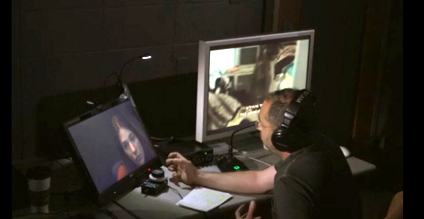
 An experiment in how people will react to videos of Israeli army and settler interactions with Palestinians becomes a fascinating study challenging assumptions about viewers and their judgments about film and images.
An experiment in how people will react to videos of Israeli army and settler interactions with Palestinians becomes a fascinating study challenging assumptions about viewers and their judgments about film and images.
Israeli filmmaker Ra’anan Alexandrowicz made several award-winning documentaries before moving from Israel to Philadelphia four years ago. I remembered him from an interesting 2003 fiction film called James’ Journey to Jerusalem, in which a young Jewish African man emigrates to Israel and is surprised by the racism he experiences from other Jews. The theme was serious, but the treatment was low-key, scrupulously respectful of the characters, and often humorous. His documentary work is also compassionate and open-minded. The latest of these, from 2019, is the simplest and at the same time most provocative of Alexandrowicz’s films. It’s called The Viewing Booth.
Alexandrowicz invited seven Temple University students to watch videos of Palestinian interactions with the Israeli military and settlers, about half of the videos by a human rights group, critical of Israeli policy, called B’Tselem, and the other half by various pro-Israel sources. They were encouraged to express their thoughts and feelings while watching. One of the seven students had to cancel, and a young Jewish student named Maia Levi expressed interest in being part of the project, so she ended up filling that slot. It is her experience viewing the videos in a booth that we are first shown.
Levi is intelligent, solidly pro-Israel, and expresses a lot of skepticism about the videos. Part of the time we just watch her face as she reacts to the material, and listen to her comments, and eventually we also see what she is being shown. She doesn’t accept any video on face value. For example, she says that an official IDF video showing a soldier being nice to a Palestinian kid and giving him a piece of cheese is obviously staged, and that it’s an unconvincing and ineffective message. She expresses similar doubts about the B’Tselem videos. How did cameras just happen to be in these situations where we see Israeli soldiers and settlers misbehaving? What is the context of these events, and why aren’t we being told about what preceded them?
Israeli filmmaker Ra’anan Alexandrowicz made several award-winning documentaries before moving from Israel to Philadelphia four years ago. I remembered him from an interesting 2003 fiction film called James’ Journey to Jerusalem, in which a young Jewish African man emigrates to Israel and is surprised by the racism he experiences from other Jews. The theme was serious, but the treatment was low-key, scrupulously respectful of the characters, and often humorous. His documentary work is also compassionate and open-minded. The latest of these, from 2019, is the simplest and at the same time most provocative of Alexandrowicz’s films. It’s called The Viewing Booth.
Alexandrowicz invited seven Temple University students to watch videos of Palestinian interactions with the Israeli military and settlers, about half of the videos by a human rights group, critical of Israeli policy, called B’Tselem, and the other half by various pro-Israel sources. They were encouraged to express their thoughts and feelings while watching. One of the seven students had to cancel, and a young Jewish student named Maia Levi expressed interest in being part of the project, so she ended up filling that slot. It is her experience viewing the videos in a booth that we are first shown.
Levi is intelligent, solidly pro-Israel, and expresses a lot of skepticism about the videos. Part of the time we just watch her face as she reacts to the material, and listen to her comments, and eventually we also see what she is being shown. She doesn’t accept any video on face value. For example, she says that an official IDF video showing a soldier being nice to a Palestinian kid and giving him a piece of cheese is obviously staged, and that it’s an unconvincing and ineffective message. She expresses similar doubts about the B’Tselem videos. How did cameras just happen to be in these situations where we see Israeli soldiers and settlers misbehaving? What is the context of these events, and why aren’t we being told about what preceded them? Now, this isn’t someone just lazily dismissing things and automatically parroting stuff she’s heard. Levi is sincerely engaging with the task that Alexandrowicz has set for her, and it’s fascinating.
I have to admit I was prepared to not like this film because I thought I knew what would happen. But I was wrong. Alexandrowicz asked her back for a second session. She was the only one he asked back. When he watches the videos, it demonstrates that the Israeli occupation is wrong. But her reaction to the scenes of Palestinians getting harassed was so different than his that he wanted to learn more. “If someone is already against the occupation,” he says, “that doesn’t teach us anything about how to reach an audience that hasn’t already made up its mind.” Maia Levi, he says, is his ideal viewer.
In her second session, the director probes Levi about some of the things she said in the first session. The film becomes about something much broader than the issues around Israel and Palestine. It’s about something that movies normally never talk about: the inner experience of the audience member, the viewer, and the tension between what a film shows us, and what we think and feel it. Levi presents a challenge to filmmakers and other artists who try to send a message through their work: can belief systems change because of watching a film or some other piece, and if so, how would the film accomplish that? But it’s also a challenge to the audience to recognize how people respond in many different ways to images, videos, and other media. The Viewing Booth reminds us to look first within ourselves if we are to understand.

